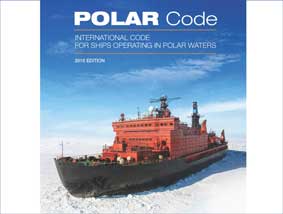A new IMO film shows how the IMO Polar Code supports safe and environmentally-friendly shipping in the Arctic and Antarctic waters.

A new IMO film shows how the IMO Polar Code supports safe and environmentally-friendly shipping in the Arctic and Antarctic waters.
Onboard the Ocean Diamond expedition ship, eco-tourists gaze at the breath-taking beauty of the Antarctic landscape. This is the chance to encounter some unique wildlife, and marvel at the sheer majesty of the glaciers and the icebergs. For them, it is the trip of a lifetime.
To make the new film about the Polar Code, an IMO team visited the Ocean Diamond en voyage in the Antarctic, to find out at first-hand what the Code means for ships like this. As Ocean Diamond’s captain Oleg Klaptenko confirmed, operating in Polar waters is the ultimate test of his ship, and his skills as a professional seafarer.
“There are several sources of danger. Low temperature, bad visibility, very long polar night and polar day. Remoteness from our home and from human facility that can help you. It is also lack of good, accurate and complete hydrographic service,” says Captain Klaptenko.
With more and more ships navigating in polar waters, the International Maritime Organization (IMO) - the United Nations agency with responsibility for regulating the safety and security of shipping and the prevention of pollution from ships - has addressed international concern about the protection of the polar environment and the safety of seafarers and passengers. It has introduced new regulations that all ships operating in these harsh and challenging waters must comply with.
The Polar Code entered into force on 1 January 2017. It sets out mandatory standards that cover the full range of design, construction, equipment, operational, training and environmental protection matters for ships making polar voyages.
These rules go above and beyond existing IMO requirements such as those governing prevention of pollution from ships (MARPOL) and safety of life at sea (SOLAS). All the extensive safety and environmental regulations included in these and other IMO conventions still apply to shipping in polar waters.
The Polar Code has two main sections. One deals with the safety of the ship and personnel, the other with protecting the environment. Ships are already subject to strict environmental regulations under the MARPOL convention, but the Polar Code adds another level. Discharging oil or oily mixtures into the sea, for example, is strictly prohibited under the Polar Code, and all oil tankers must have double hull and double bottom construction to prevent oil spills in case of an accident.
IMO’s new film shows some of the equipment specific to polar operations carried aboard Ocean Diamond - the ice picks needed to hack off any ice build-up on deck and the thermal suits for crew and passengers to be used in case of emergency, for example; and the system incorporated into the large windows on the bridge to pour hot water down the outside to melt the ice, as well as a heated panel to ensure visibility remains perfect.
Operationally, voyage planning is crucial, as is receiving accurate and up-to-date information about the state of the ice and the weather. And there are means of communication that can be used where satellite coverage is poor.
In the galley, where a dedicated team of chefs, cooks and helpers cater for more than 200 ravenous tourists and hungry crew every day, there are bins to collect food waste, paper and plastic waste which, aboard Ocean Diamond, is bagged up and taken ashore. The Polar Code has strict rules for dumping waste, and animal carcasses.
For the crew, navigating in polar waters places special challenges. “Due to the Polar Code, all crew members, as senior officers, as ratings, they have to pass special education, tests and certificates, they have to be certified for and get permission for sailing in polar waters,” says Captain Klaptenko, who has been sailing in Polar waters for 25 years and recognizes the value of specialist training.
More seafarers will need to get these skills, as shipping activity in polar regions is set to grow in volume and diversity over the coming years. Receding sea ice is opening up these inhospitable regions to both commercial shipping and tourism.
As the film stresses, the issue is not whether this activity is a good thing. The issue how it is managed so that we protect the environment and safeguard the lives of people who live and work in such a remote arena.
And that is where IMO’s Polar Code comes in.
See how the Polar Code comes into play aboard the Ocean Diamond, in a new IMO film, which is available now on IMO’s YouTube channel.
